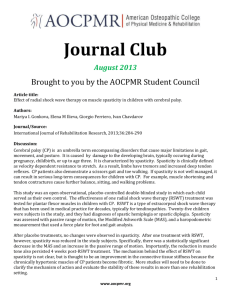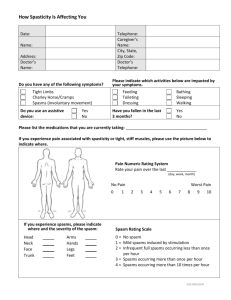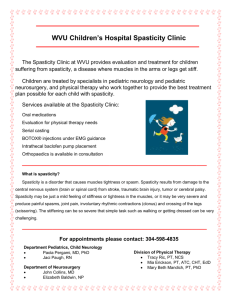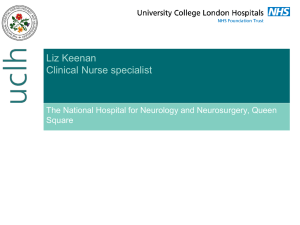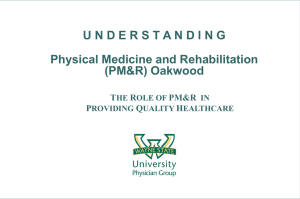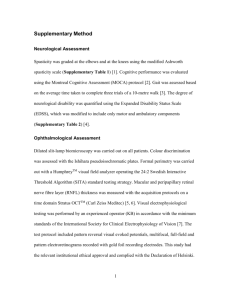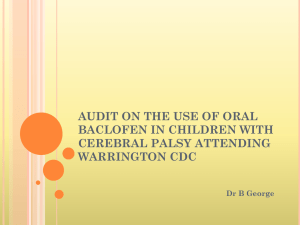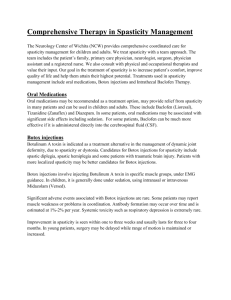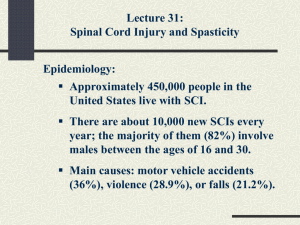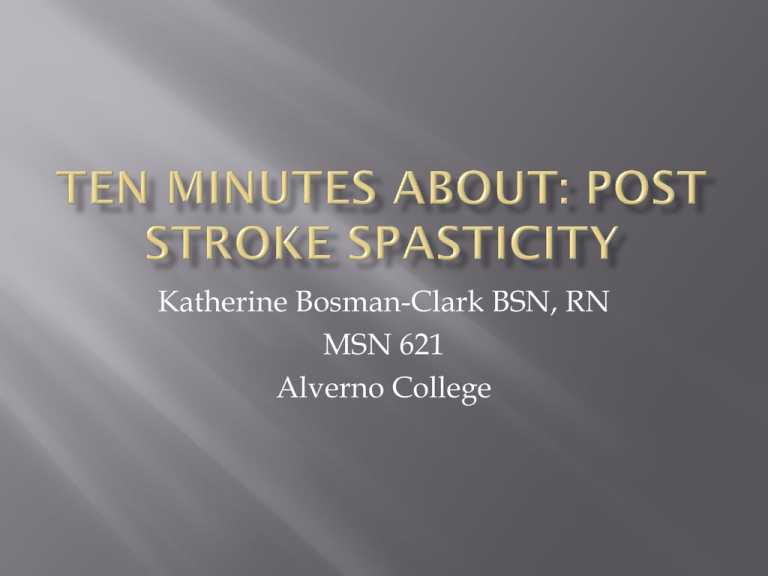
Katherine Bosman-Clark BSN, RN
MSN 621
Alverno College
Mr. Johnson is a 75 year old male who suffered
a stroke 4 months ago. Following his hospital
stay he spent one month in an hospital-based
inpatient rehabilitation program (rehab). He
progressed well and was able to go home with
a few adaptations made to his living space. He
goes to a clinic several times a week for
outpatient physical and occupational therapy.
In the past few weeks he has noticed frequent
jerking movements in his left arm. They are
painful, involuntary and he finds them
embarrassing.
A look at the causes of one of the most
common post-stroke side effects – spasticity
An understanding of the pathophysiology of
spasticity
An overview of the most common treatments
for spasticity
Spasticity is caused by ineffective transmission
of nerve impulses. It is usually caused by a
disturbance in an upper motor neuron and
results in “intermittent or sustained
involuntary contraction of muscles” (2). This
condition has a significant impact on activities
of daily living because of reduced range of
motion, painful spasms, and muscle
contractures (4).
What symptoms does Mr. Johnson have
that indicate spasticity?
Involuntary
jerking in his
arm.
Right!
Increased
somnolence.
This may occur after
stroke, but is not related
to spasticity. Try again!
Continued need
for therapy.
Most patients need
therapy post stroke,
regardless of spasticity.
Try again!
Spasticity is caused by incomplete transmission
of impulses from alpha motor neurons of the
brain (5, 8). Alpha motor neurons are responsible
for innervating skeletal muscles with their cell
bodies in the brain or spinal cord and axons
ending in the skeletal muscles (2).
Image provided by Brad Walker and The Stretching Institute. Copyright © 2012. All rights reserved.
Brad is a leading stretching and sports injury consultant with more than 20 years experience in the
health and fitness industry. View more articles
here.... http://www.thestretchinghandbook.com/archives/myotatic-stretch-reflex.php
GABA is the primary inhibitor of impulses
crossing synapses in the central nervous
system (CNS) (6). When GABA binds to its
receptors, channels open allowing chloride ions
into the cell and potassium ions out of the cell.
(6). In spasticity receptors do not bind GABA
effectively and consequently nerve impulses
are not inhibited, leading to over contraction of
the muscle.
Contractures result when muscles are
shortened for an extended period of time (8).
Spasticity exacerbates functional limitations
associated with stroke (2).
In general, spasticity causes a decrease in a
person’s functional independence.
How can spasticity negatively impact a
patient?
It doesn’t.
Spasticity is a painful
and inhibits patient’s
ability to preform
ADLs. Try again!
Contributes to risk
for anther stroke.
Spasticity does not
increase stroke risk. Try
again!
Can decrease
quality of life.
Right!
Pharmacologic measures exist as effective
treatments for spasticity (3)
Physical, occupational, and speech therapy all
play important roles in treatment (2)
The patient and caregivers are also important
for setting goals of treatment (2)
Drug
Mechanism of Action
Side Effects
Baclofen (Lioresal)
Structural analog of
GABA (inhibitory
transmitter of CNS) (2)
Drowsiness, sedation,
muscle weakness (2)
Tizanidine (Zanaflex)
Alpha-2 adrenergic
agonist, binds to spinal
receptors to block release
of excitatory
neurotransmitters (2)
Drowsiness, dry mouth,
weakness, hypotension,
elevated liver function
tests (2)
Diazepam (Valium)
Increases effects of
GABA at CNS synapses
(3)
Fatigue, drowsiness,
reduction in motor
coordination (3)
Dantrolene Sodium
(Dantrium)
Acts on skeletal muscles
by reducing strength of
contraction (3)
Decrease in gross motor
function (3)
What is a common side effect of oral
agents used to treat spasticity?
Drowsiness.
Right!
There are no
negative side
effects.
All medications have
side effects. Try again!
Dysuria.
Post-stroke spasticity
does not impact the
bladder. Try again!
Goals (6)
Increase stretch in shortened
muscles and tendons
Decrease over-activity of
muscles
Tools (2)
Stretching programs tailored to
the patient’s needs
Braces and/or serial casting
Improve muscle strength
Increase muscle control
Electrical stimulation
What is the goal of therapy treatments
for spasticity?
To encourage
use of
medication
Try again.
Improve the
patient’s quality
of life
Right!
To provide work
for PTs and OTs
Try again.
Spasticity post-stroke has the potential to
greatly impact a patient’s quality of life
Although the causes of spasticity are not well
understood, there are treatment options
Both pharmacologic and non-pharmacologic
measures may be helpful in treating spasticity
1) Alpha Motor Neuron. (September 12, 2011). Retrieved April 4, 2012 from Wikipedia:
http://en.wikipedia.org/wiki/Alpha_motor_neuron.
2) Francisco, G.E., & McGuire, J.R. (2009). Physiology and management of spasticity
after stroke. In J. Stein, R.L. Harvey, R.F. Macko, C.L. Winstein, & R.D. Zorowitz
(Eds.), Stroke Recovery and Rehabilitation (413-436). New York, NY: DemosMedical.
3) Gallichio, J. (2004). Pharmacologic management of spasticity following stroke.
Physical Therapy, 84(10), 973-981.
4) Kumar, R. T., Pandyan, A. D., Sharma, A. K. (2006). Biomechanical measurement of
post-stroke spasticity. Age and Ageing, 35, 371-375.
5) National Institute of Neurologic Disorders and Stroke, National Institutes of Health.
(2011, October 4). NINDS Spasticity Information Page. Retrieved April 4, 2012 from
http://www.ninds.nih.gov/disorders/spasticity/spasticity.htm.
6) Porth, C. M. & Matfin, G. (2009). Pathophysiology Concepts of Altered Health States (8th
ed.) (pp.1189-1190). New York, NY: Lippincott, Williams &Wilkins.
7) Satkunam, L. E. (2003). Rehabilitation medicine: 3. Management of adult spasticity.
Canadian Medical Association Journal, 169(11), 1173-1179.
8) Vanek, Z.F., Berman, S.A. (2010). Spasticity. Retrieved April 4, 2012 from
http://emedicine.medscape.com/article/1148826-overview.
Walker, B. (2012). Understanding the Stretch Reflex, picture. Retrieved April 24, 2012
from http://www.thestretchinghandbook.com/archives/myotatic-stretchreflex.php.

